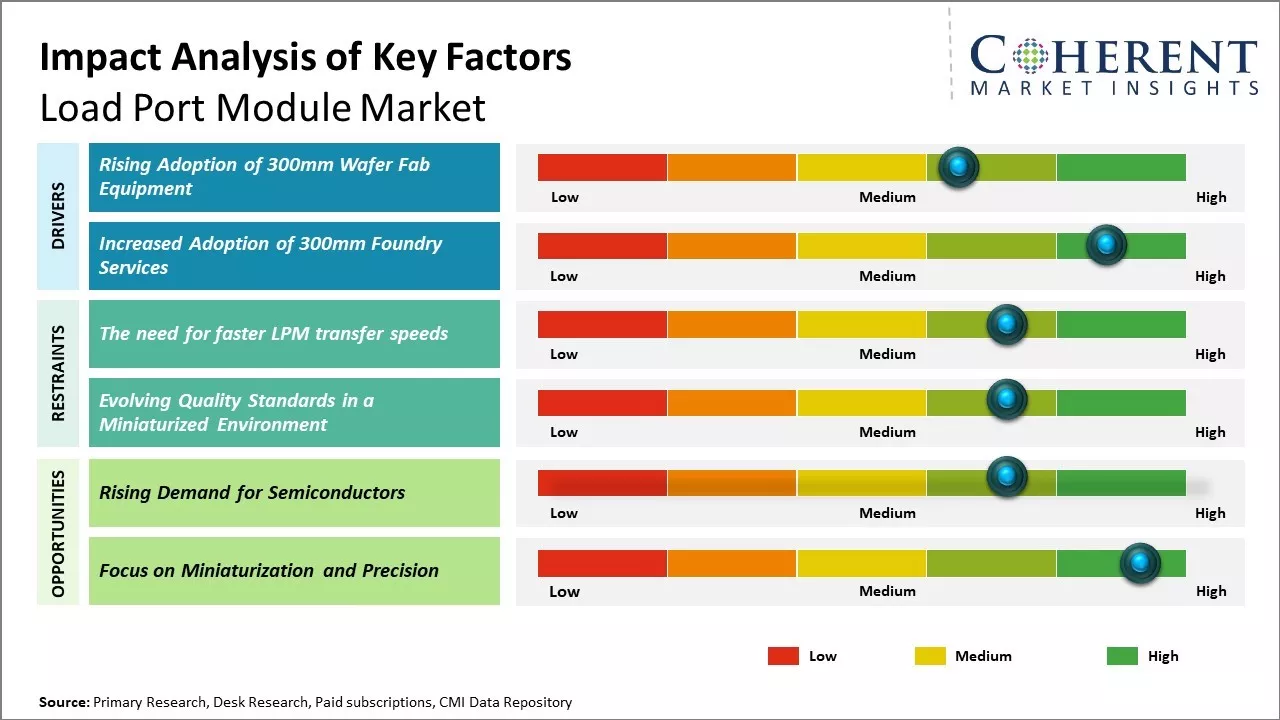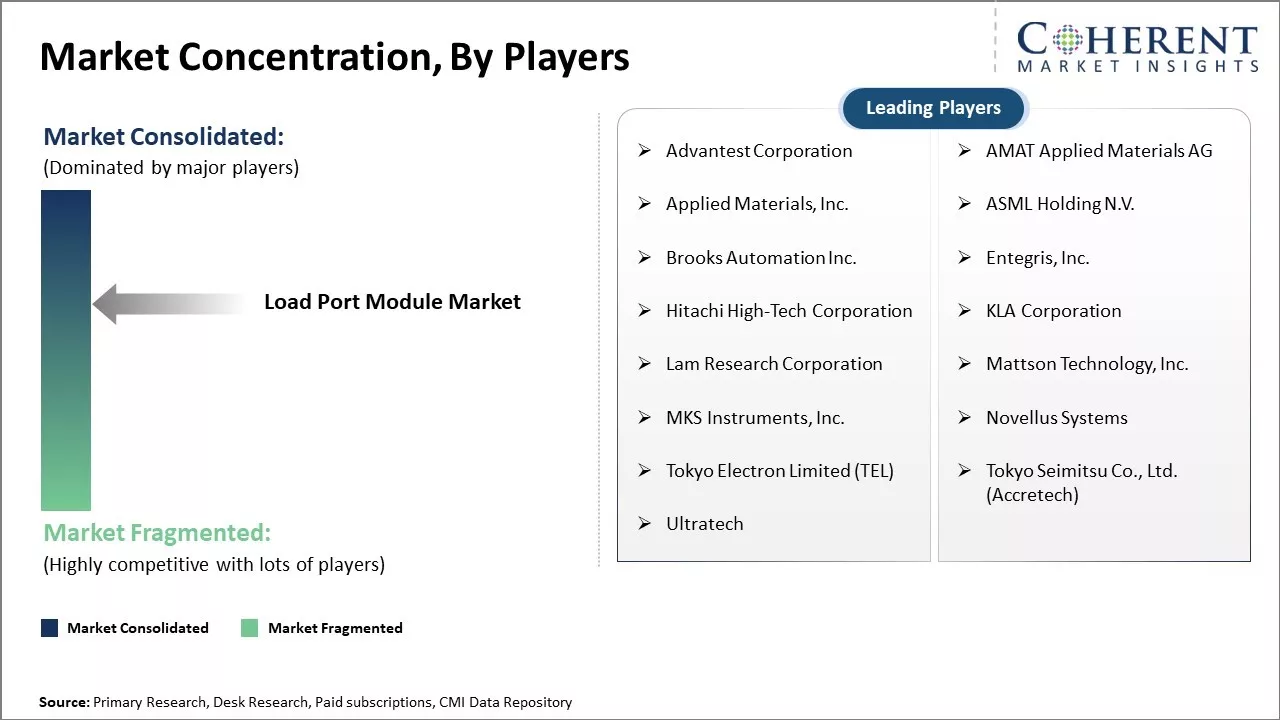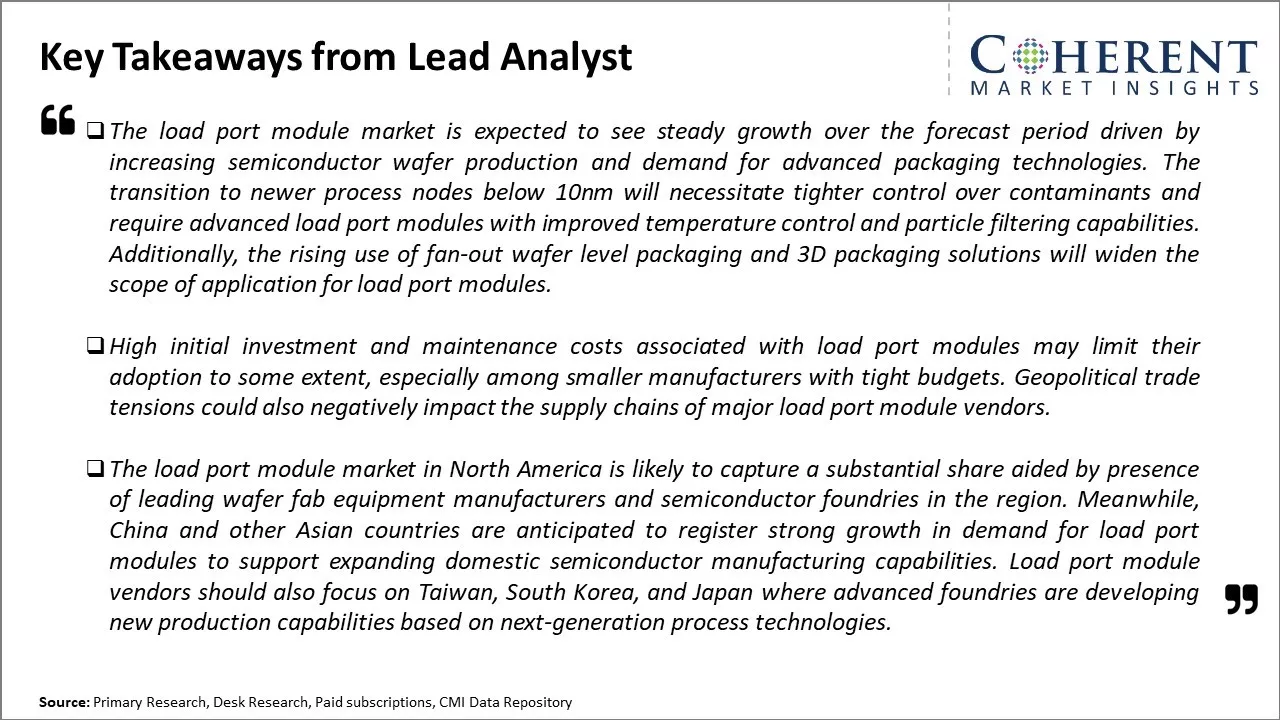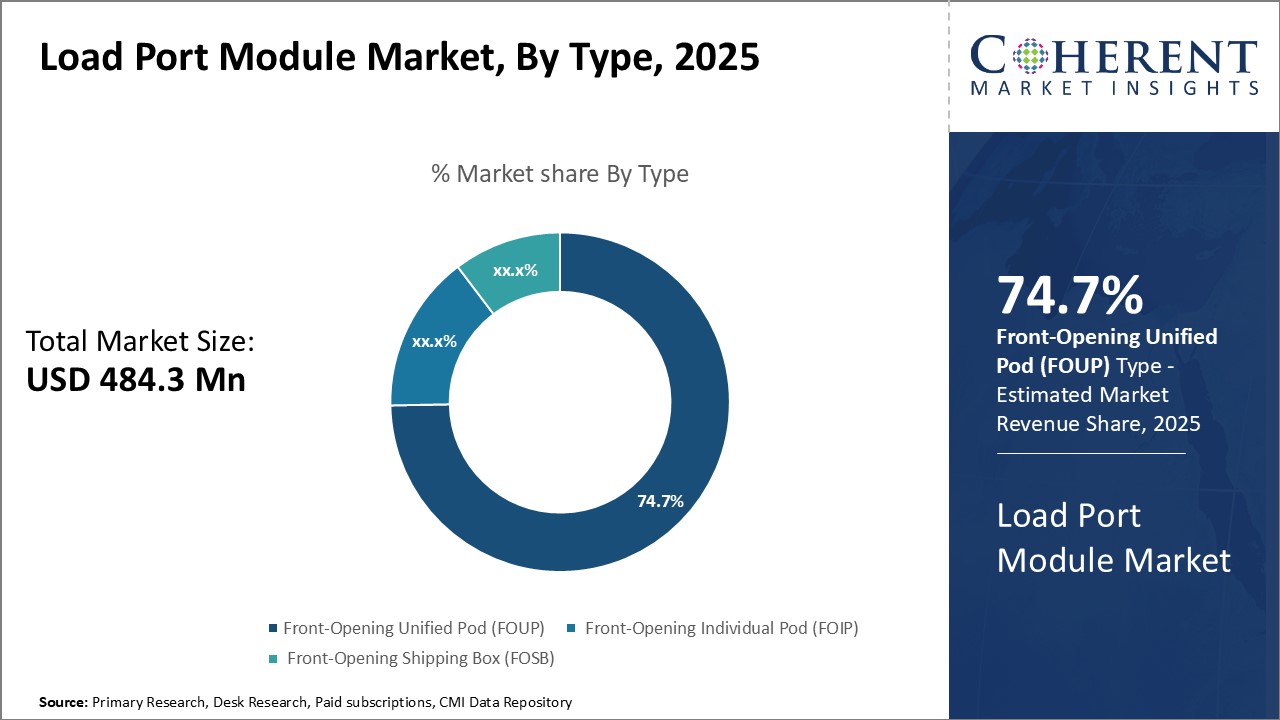Global load port module market is estimated to be valued at USD 484.3 million in 2025 and is expected to reach USD 874.6 million by 2032, exhibiting a compound annual growth rate (CAGR) of 8.8% from 2025 to 2032.

Discover market dynamics shaping the industry: Request sample copy
Global load port module market is expected to witness significant growth during the forecast period due to increasing demand for semi-conductors from consumer electronics and automotive industries and expansion of fabs globally. Load port modules play a crucial role in transferring wafers between processing tool and wafer storage in the fabrication facility. Growing need for low volume, high mix production requiring frequent setup changes has increased demand for faster load ports having higher throughput. Adoption of Industry 4.0 technologies such as artificial intelligence, internet of things in semiconductor manufacturing has also boosted the market growth. However, high initial investment and maintenance costs associated can hamper the growth of load port module market to some extent.
Rising Adoption of 300mm Wafer Fab Equipment
As the semiconductor industry continues to pursue Moore's law and demand for increased chip performance and integration, chipmakers are increasingly adopting 300mm wafer fab equipment for manufacturing. Producing chips on 300mm wafers allows for significantly higher yields and lower per-unit fabrication costs compared to 200mm wafers. This shift to larger wafers necessitates compatible load port module equipment that can efficiently handle, transfer and track the larger wafer sizes throughout the fabrication process.
Many leading foundries and IDMs have heavily invested in expanding their 300mm wafer fab capabilities over the past decade. Major facilities supporting 300mm production have been established across Asia and some parts of the U.S. and Europe. With the higher capital expenditures required for 300mm equipment, manufacturers are aiming to maximize the equipment utilization rates and productivity to best realize returns on these investments. Precise and automated load port modules play a key role in ensuring smooth material transport and high throughput within the fabrication lines. Any inefficiencies or interruptions caused by load port equipment could greatly impact the overall equipment efficiency. As such, chipmakers are inclined to use load port modules from reputed suppliers with a strong track record of reliability and service support. This growing transition to 300mm boosts demand prospects for load port module manufacturers catering to the specific requirements of 300mm fabs.
For instance, Applied Materials launched its new load port module for 300mm Wafers in January 2022. This new module is designed to provide a more efficient and flexible solution for the loading and unloading of 300mm wafers in semiconductor manufacturing systems. The module features a number of innovative design features, including a modular design, a high-speed load/unload mechanism, and a built-in temperature controller.

Get actionable strategies to beat competition: Request sample copy
Increased Adoption of 300mm Foundry ServicesIn addition to the shift to 300mm wafer production internally by IDMs, the business model of outsourcing chip manufacturing to specialized foundries utilizing their 300mm fabrication infrastructure has gained significant traction over the years. Foundries such as TSMC and GlobalFoundries have made massive capital investments to establish leading-edge 300mm wafer fabrication facilities. An exponentially growing number of fabless semiconductor companies as well as IDMs outsourcing portions of their manufacturing are leveraging these foundry partners' 300mm services. This outsourcing trend allows chip design firms to focus on their core competencies while accessing some of the most advanced process technologies without having to bear the high fixed costs of setting up their own 300mm fabs.
In order to meet the rapid turnaround times and high volume manufacturing requirements of their clientele, foundries need to ensure wafer lots can smoothly traverse through the various production line steps with minimal logjams or disruptions.
For Instance, In September 2023, Tower Semiconductor and Intel Foundry Services (IFS) revealed a partnership where Intel will offer foundry services and 300mm manufacturing capability to help Tower serve its customers worldwide. Tower will utilize Intel's advanced manufacturing facilities in New Mexico as part of this agreement.

To learn more about this report, Request sample copy
Market Challenges: The need for faster LPM transfer speedsGlobal load port module market faces several challenges. As semiconductor fabrication facilities drive towards higher productivity and output, there is increased demand for faster load port module transfer speeds which require advanced technologies. This increases costs and development timelines for load port module manufacturers. Further, highly competitive nature of the semiconductor industry results in pricing pressure on load port module suppliers. Customers often negotiate on price which shrinks margins. Quality standards are also continuously rising with new materials and miniaturization trends, requiring upgraded load port module designs that can handle smaller parts with precision.
Market Opportunities: Rising Demand for Semiconductors
Global load port module market also presents several opportunities for growth. The demand for semiconductors shows no signs of slowing as chips become integral to more electronic devices and data centers. This guarantees a steady need for load port modules to interface fabrication tools. Asia Pacific continues rapid expansion in semiconductor manufacturing presenting a large untapped market region.

Discover high revenue pocket segments and roadmap to it: Request sample copy
In terms of By Type, Front-Opening Unified Pod (FOUP) contributes the highest share of the market owning to its enhanced compatibilityFront-Opening Unified Pod (FOUP) segment is expected to dominate the load port module market with 74.7% of share in 2025, owing to its enhanced compatibility and wider application scope. FOUP offers a standardized and unified pod solution which can be loaded onto different automation equipment without any modifications. This universal compatibility enables greater transfer of wafer cassettes between various processing tools within a fabrication facility.
The standardized FOUP dimension and interface mechanism helps minimize manual human intervention and reduces complexities during automated cassette transfers. This further helps improve process productivity and yield. FOUP also offers superior contamination control compared to its counterparts owing to its fully-sealed and environmentally protected pod interior. The front-opening access mechanism prevents particulate contamination during transfers. This makes FOUP a reliable and preferred solution for manufacturing highly advanced semiconductor devices with smaller node sizes that require extremely high purity levels. Overall, the universal compatibility and enhanced contamination control offered by FOUP have helped it gain higher market penetration over other load port module types.
In terms of Automation Level, Fully Automated Load Port Module leads the market owing to rising demand for enhanced automation
Fully Automated Load Port Module segment is expected to hold the largest market share of 48.64% in 2025, owing to the rising demand for enhanced wafer fabrication automation. With continuous scaling down of semiconductor device features, chip manufacturing has become an extremely complex process that requires higher precision and minimal human intervention to reduce errors. This has increased the adoption of fully automated load port modules across fabrication facilities.
Fully automated load port modules provide complete autonomous capabilities for loading and unloading of wafer cassettes without any manual assistance. The advanced actuators, sensors and control systems enable precise handling, self-aligning, and transferring of wafers under strict production protocols. This significantly improves tool utilization and boosts overall equipment effectiveness (OEE). Such advanced automation helps maximize tool uptime and ensures consistent wafer movements for seamless high volume manufacturing.
The inherent benefits of enhanced precision, minimal errors, higher throughput and optimal assets utilization have accelerated the replacement of semi-automated and manual load port modules with fully automated variants across major fabrication units. Furthermore, fully automated load port modules comply with stringent cleanroom environmental norms and help minimize wafer defects attributable to particle contaminations during cassettes transfers. Thus, the widespread need for increasing operational excellence is driving stronger market dominance of fully automated load port modules.

Need a Different Region or Segment? Customize now
North America has established itself as the dominant regional market for load port modules and is expected to hold the largest share of 37.7% in 2025. Major semiconductor manufacturers from the U.S. and Canada have been setting up advanced chip fabrication facilities in the region for decades. With a strong presence of companies like Intel, Micron, Texas Instruments and GlobalFoundries, North America accounts for over 30.5% of the worldwide wafer fab capacity. The sustained capital expenditure on building new fabs and upgrading existing fabs has created steady demand for load port modules in North America.
Furthermore, the major load port module suppliers also have their manufacturing and R&D centers located in North America in close proximity to their biggest customers. For instance, companies like Entegris, Brooks Automation and Hirata Corporation manufacture over 50.5% of their total load port module production within North America to serve the local fab requirements with reduced lead times. This localized manufacturing strategy has helped them gain significant cost advantages over Asian competitors in the region. Access to experienced engineering talent pool and support for localized customization requests from North American chipmakers has further strengthened their position.
China has emerged as the fastest growing regional market for load port modules globally over the past 5 years and is expected to grow with the CAGR of 12.3% in 2025. Ambitious capacity expansion plans of leading Chinese foundries like SMIC and Hua Hong along with growing investments from memory makers like Yangtze Memory and ChangXin have fuelled demand. The Chinese government's initiatives to cultivate a self-reliant semiconductor industry and reduce reliance on U.S. chip imports have accelerated this growth. Local load port module manufacturers are also strengthening their design and manufacturing capabilities through technical partnerships. Coupled with relatively lower operating costs compared to mature markets, Chinese suppliers have been capturing a considerable share of the domestic market. Sustained capacity additions in years to come are expected to propel China to one of the top regional markets for load port modules worldwide.
Load Port Module Market Report Coverage
| Report Coverage | Details | ||
|---|---|---|---|
| Base Year: | 2024 | Market Size in 2025: | USD 484.3 Mn |
| Historical Data for: | 2020 To 2024 | Forecast Period: | 2025 To 2032 |
| Forecast Period 2025 to 2032 CAGR: | 8.8% | 2032 Value Projection: | USD 874.6 Mn |
| Geographies covered: |
|
||
| Segments covered: |
|
||
| Companies covered: |
Advantest Corporation, AMAT Applied Materials AG, Applied Materials, Inc., ASML Holding N.V., Brooks Automation Inc., Entegris, Inc., Hitachi High-Tech Corporation, KLA Corporation, Lam Research Corporation, Mattson Technology, Inc., MKS Instruments, Inc., Novellus Systems, Tokyo Electron Limited (TEL), Tokyo Seimitsu Co., Ltd. (Accretech), Ultratech |
||
| Growth Drivers: |
|
||
| Restraints & Challenges: |
|
||
Uncover macros and micros vetted on 75+ parameters: Get instant access to report
*Definition: The load port module market offers loading modules used for the transfer of wafer cassettes or batches of silicon wafers between the wafer transport system and processing equipment in semiconductor manufacturing facilities. Load port modules provide an interface for automated material handling equipment to deliver wafer cassettes or batches from storage containers into processing tools like etchers, deposition systems, and inspection equipment. These modules are designed for efficient wafer handling while maintaining high particulate and contamination control standards required for semiconductor fabrication.
Share
Share
About Author
Raj Shah is a seasoned strategy professional with global experience, from strategy to on-the-ground operational improvements. In last 13 years, he has executed number consulting projects focused on consumer electronics, telecom and consumer-internet business leading multiple long-term engagements towards mobilizing and executing on break-through strategy - leading to tangible sales results. Raj is also acting as a strategy consultant for one of the leading online hyper local service providers in India, contributing to their growth through critical strategic decisions. Raj usually spends time after office in talking to the passionate entrepreneurs, regardless of their funding status.
Missing comfort of reading report in your local language? Find your preferred language :
Transform your Strategy with Exclusive Trending Reports :
Frequently Asked Questions
Joining thousands of companies around the world committed to making the Excellent Business Solutions.
View All Our Clients
US Reciprocal Tax Impact Analysis On Load Port Module Market
Stay updated on tariff changes with expert insights and timely information